|
11/12/2020 |
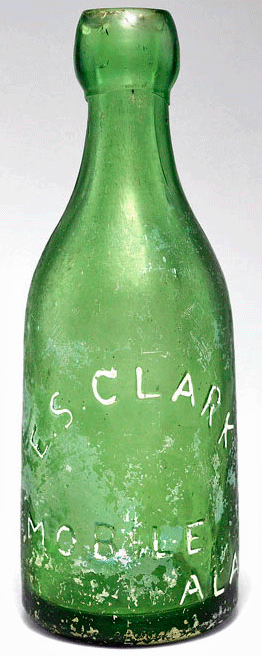 While researching the origins of a Wells & Company
bottle, I was reintroduced to Clark and his many
partnerships. One being Clark & Wells in Mobile,
Alabama. Before I
get into the Mobile bottles, some background on Edmund S. While researching the origins of a Wells & Company
bottle, I was reintroduced to Clark and his many
partnerships. One being Clark & Wells in Mobile,
Alabama. Before I
get into the Mobile bottles, some background on Edmund S.
Edmund S. Clark was born at Northampton, Massachusetts on
January 26, 1826. Edmund married Julia A. Hilliard on
January 2, 1845 at Halifax, Vermont. She was the
daughter of John and Hannah Hilliard. They were both
from North Hadley, Massachusetts. The next reference that I
can find is the 1850 Hadley, Massachusetts Census where
Edmund is listed as a broom maker. Also listed is
Julia, Hannah Hilliard, her mother, and three other boarders
who were also broom makes. Julia died on August 8,
1876 in Massachusetts and was recorded as a widow.
The infamous Johnnie Appleseed of the soda industry,
Philo M. Clark, was from Hadley as well. In 1850,
Philo had moved to Illinois, where he was a clerk and his
father, also named Philo, was a broom
maker. The younger Philo and Edmund were not siblings, but must have been
related as they were long distance business partners in
later years. Likely Edmund was an uncle.
The first reference to Edmund in the soda water business
was his association with J. H. Kump, as J. H. Kump &
Company. They were located in both Vicksburg and, just
down the river, in Natchez , Mississippi in 1864. J. H. Kump
was a partner with Philo Clark in Memphis, Tennessee, prior
to the outbreak of the Civil War. Natchez was
relatively undamaged by the Civil War and was occupied
by General Grant in 1863, but Vicksburg was not so lucky. Kump and Clark may have set
up shop in these two cities to serve the serve the Federal forces and a
large number of refugees who migrated to these cities. The
following is the earliest advertisement that appeared in the
Natchez Daily Courier on August 8th, 1864:
J. H. Kump & Co.
LEMON AND SARSAPARILLA.
MINERAL
WATERS.
LABRATORY AT J. H. HARRIS' OLD stand under the
Hill. orders filled and delivered in any part of
the city
In any case, the Vicksburg partnership was
dissolved on October 22, 1864, with Kump as the surviving
partner. The Natchez partnership was dissolved a few
days earlier on
October 19th, 1864, with Clark being the surviving partner.
Clark continued to run the Natchez operation thru
December of 1866, or at least that is the last advertisement
that I could find in that City. This ad ran
continuously since April of that year. The last
non-recurring reference appeared in the Natchez Daily Courier on
June 14th, 1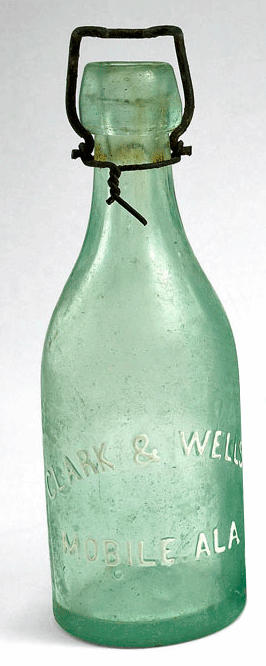 866: 866:
PHIZ Z-Z-Z--POP ! The clever
employees at E. S. Clark's Laboratory, seem determined
to keep us under obligation to them.
Nothing is more delicious and refreshing this hot weather, than the
Mineral Waters prepared and sold by them all over the
City.
An IRS Tax filing was made by E. S. Clark for September,
1866. Clark appears in the Weekly Democrat's Natchez dead
letter advertisement on August 19, 1867, which demonstrates
that he left the City by then. I think we can safely
conclude that Clark concluded the Natchez operations in the
Fall of 1866. There are no known Clark or Kump bottles
marked Vicksburg or Natchez.
Meanwhile, Clark was also running a soda bottling
manufactory in Mobile, Alabama. Initially, Clark
partnered with William C. Wells in the operation. The
earliest record that I can find for this partnership is for
four barrels of bottles that they received from the steamer
Flirt as advertised in the Advertiser and Register on
September 23, 1865. It is not known when this
partnership was formed or if the two were operating
individual business prior to this partnership. In any
case, the partnership was dissolved on October 12, 1865 as
published in The Mobile Daily Times on October 24, 1865:
Dissolution
The firm of CLARK Á WELLS is this day mutually dissolved. All debts due from the firm and to
the firm will be paid and resolved by E. S. CLARK.
Mr. Clark will continue the Bottling business, Mr. Wells will continue the Fountain business,
at the old stand, corner Dauphin and Franklin streets.
E. S. CLARK,
WM. C. WELLS.
Mobile, Oct. 12th, 1865
Clark operated the business thru early winter, but
partnered with Asa E. Munn, also from Massachusetts, in the soda bottling business on
January 17, 1866 as advertised in The Mobile Daily Times on
January 25, 1866: NOTICE.
I have this day associated with me in business, A. E. MUNN, and will continue the business of manufacturing and bottling Soda Water,
in all its branches, at the old stand of E. S. Clark, under the name and style of Clark & Munn.
E. S. CLARK.
Mobile, Ala, Jan. 17, 1866.
This partnership also operated a branch location in
Pensacola, Florida.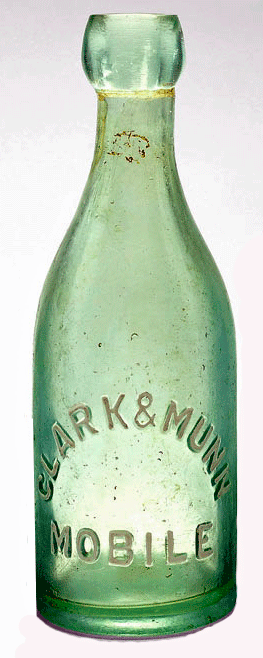 Clark ran the Mobile plant and Munn the
Pensacola plant. The business continued through 1866 with the pair
advertising their product in local papers Mobile papers. Like this
notice in The Mobile Daily Times on June 14, 1866:
Clark ran the Mobile plant and Munn the
Pensacola plant. The business continued through 1866 with the pair
advertising their product in local papers Mobile papers. Like this
notice in The Mobile Daily Times on June 14, 1866:
CLARK & MUNN-Everybody says it is too hot to drink
"pine top." What everybody says must be true, but it is
not too hot to indulge in the pleasure of drinking to
your full satisfaction some of Messrs. Clark & Munn's
Soda Water. It is a cheap luxury. By leaving
your order at their place of business, on Franklin
street, between Dauphin and St. Francis Streets, you can
have a dozen or so of bottles left at your residence at
any time, at the small cost of 75 cents per dozen.
The children even are getting familiar with the boxes
marked Clark & Munn, which are occasionally brought to
their door.
The soda water, by Messrs. Clark &
Munn, is precisely the same as that sold at most soda
fountains.
"Pine top" was a hot tea drunk by "country people" in the
spring and fall to prevent colds. I was not able to
locate any Pensacola advertisements. The last
advertisement I found for this firm was in The Mobile Daily
Times on February 22nd, 1867:
Mineral and Soda Water.
The subscribers take this opportunity to express their thanks
to their former patrons, and assure them and all others who may favor us with their orders, that their increased facilities this
year will enable them to meet all calls for their superior SODA AND MINERAL WATERS, and that nothing but an A No. 1 article will
be turned out at their old stand, northwest corner of Dauphin and Franklin streets.
fe20 1y
CLARK & MUNN This ad was first un in February of 1866 and prepaid to run
for a full year. The previous ad from June of 1866,
indicates that the plant moved from the corner of Franklin
and Dauphin, to Franklin between Dauphin and St. Francis
streets. They also were listed in the 1867 Directory
with a slight clarification that the plant was on the "east
side" of Franklin. The exact date of dissolution of the
Clark & Munn partnership is currently not known, but must
have ended by May 4, 1867 when the following ad appeared in
The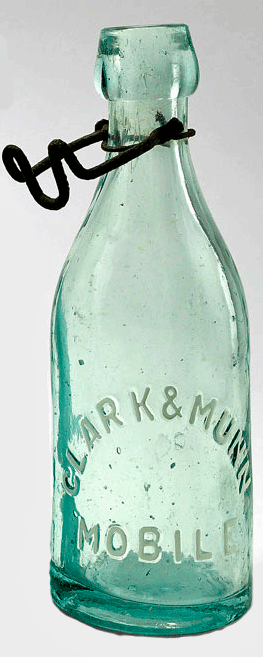 Mobile Daily Times: Mobile Daily Times:
LOST BOTTLES.
Notice is
hereby given to parties having in their possession SODA
WATER BOTTLES, with my name on them or of the old firm,
Clark & Munn, and all other brands, also plain, that
they are expected to return them to me at once, as they
are my private property. Parties having bottles
can notify my drivers, or address me through the
Postoffice. The sale of said bottles is strictly
prohibited, and parties so doing are warned that they
will be prosecuted.
E. S. CLARK.
We can conclude that the partnership ended in March or
April of 1867. Clark continued to operate Mobile plant
alone for several years. Advertising sporadically over
this time period. An examples include This ad from The
Mobile Daily Times on October 27, 1867:
E. S. Clark, the great soda and mineral water man, has not failed in his duties to the poor, having gratuitously
supplied many families with this health giving beverages during their convalescence.
Soda
water, or rather seltzer water, is one of the most active restorers of appetite after a long and telling disease.
A January 6, 1868 article again in The Mobile Daily
Times, comments on the warm weather:
SODA-SELTZER-KINSINGEN.-We had determined, on the
approach of cold weather, to give the go-by to those
delicious summer drinks, but Dame Nature is so capricious
that she has again mislaid her almanac, and is now coming
out in her full summer dress.
So our
parched throats are again forced toward that fount of
refreshing drinks which E. S. Clark controls, and which
alone can quench the almost feverish thirst of this second
Indian Summer.
The last Advertisement I found for Clark was in The
Mobile Daily Register on June 4th, 1868:
Soda and Mineral Water
E. S. CLARKE, manufacturer, Franklin, bet. Dauphin and St. Francis sts.
Families orders promptly attended to at 75c. per dozen.
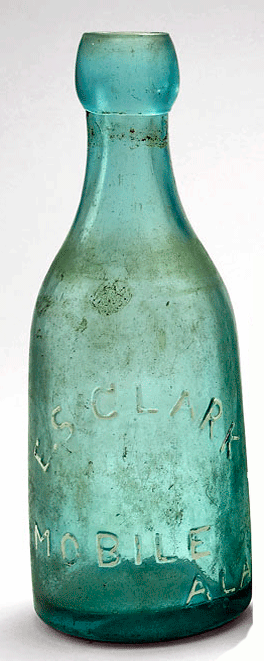 The last reference I can find for Clark on his own, was
in The Mobile Register on June 30, 1869 where he is listed
as a consignee in the Shipping News section as having a
receipt of goods aboard the steamer Francis.
Clark was involved in a bit of a scandal during 1868.
While still married to Julie A. in Massachusetts, Clark,
aged 44, married 24 year old Mary E. A. Rous on July 27,
1868. Mary A. E. Hanley married Layfield Rous, a
blacksmith, on June 18, 1861. He became a grocer later
in life and died sometime shortly before the marriage.
Mary had a son aged 5 at this time. The couple had a
child Irene Mary born on June 20, 1869 and was Clark's only
child. She died on October 16, 1871.
In the 1870 Memphis directory, Clark was a part of the
firm of E. S. Clark & Company. The partner was Philo
M. Clark of Oil City, Pennsylvania. It is not certain
how long this partnership lasted and no other material
references can be found to Clark during this period other
than a mention of an accident with one of his wagons and him
donating soda water to a church bazaar. Clark & Co.
were mentioned as supplying a soda fountain to a church
function on April 20, 1870.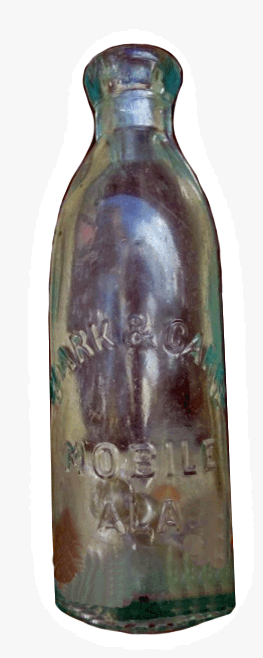
In the later period of 1870 or early 1871, Cark joined
forces with another Mobile soda water bottler, Edmund Carre
as Clark & Carre. Carre in 1875 advertised that his
business was established in 1868. Not much advertising
can be found for this partnership. The firm used
Mathews Gravitating Stoppered bottles for the first time.
Prior to this time all bottles were cork stoppered.
Clarke & Carre dissolved their relationship some time
during 1873 and Clark died soon after on August 28, 1874 and
was buried at Meridian, Mississippi. Carre was the
surviving partner and went on to
be a successful bottler of soda and mineral waters. In
1892 he formed the firm of E. Carre Company, which operated
until 1930 under J. C. Wilkins. The plant was listed
as being abandoned in 1931. As a side note, the E.
Carre Company bottled a drink called Fosko, "a delicious
fruit drink with the flavor like rare old wine" and
Carre-Cola in 1914. Foska continued to be sold into
the 1920s and it was advertised it extensively with large
ads. Wilkins left the soda water business in 1930, but
resurfaced ten years later, in 1939 or 1940, founding the
Fosko Bottling Company, which operated under various owners
until about 1952.
The table below provides a count by this breakdown and
links to the dated bottles:
| Clark & Wells |
Sept 1865 or Earlier |
10/12/1865 |
| Edmund Clark |
10/12/1865 |
1/17/1866 |
| Clark & Munn |
1/17/1866 |
March or April 1867 |
| Edmund Clark |
March or April 1867 |
1869 |
| E. Clark & Company |
1869 or 1870 |
1870 |
| Clark & Carre |
1870 or1871 |
1873 |
| E. Carre |
1873 or 1874 |
1891 |
| E. Carre Company |
1891 or 1892 |
1930 |
| Fosko Bottling Company |
1939 or 1940 |
1952 |
Pictures courtesy of Glass Works Auctions.
|
|
|
4/25/2020 |
In discussions with fellow collectors, we often muse
about what are the top 5 or 10 bottles in our collecting
realm. The lists are often prejudiced by each collector's
interests they have different criterion that factor into
this personal decision. Some value historical
relevance, some colors, some rarity, some were the bottles
is from, etc.
I have often thought to myself what is the best soda bottle in the United States.
To think about that rationally and remove any personal
biases, I would have to have a rational list of attributes
that can be used to determine the best of the best. I
need to look at this with the eye of a national collector.
One who cares more about the bottle than where it is from.
A collector of Savannah bottles would value a pink Ryan
whereas a collector from Saint Louis may pick the M & W
tenpin. Their eyes are only for their city, state, or
region.
- The first thing I need to consider is history and
age. Since there are few bottles that commemorate
historical events or individuals, this does not weigh in
to heavily, but some of these bottles illustrate the
history of soda water industry. Bottles like the
"Remember the Maine" Hutchinson and "Taylor Never
Surrenders" soda bottle have heightened collector
interest, but there are to few of these and generally do
not have other qualities that would drive them to the
top slot. Collectors generally want the earliest
bottles in their collecting category, so age is
important. The earliest soda bottles are pontiled.
So the top bottle must be pontiled.
- The second consideration is rarity. A bottle
that is readily available just precluded itself from
being the top bottle. The to bottle is one that
everyone want and very few have. Along with rarity
and appeal come a high value. So the top bottle
must be very rare, with just a couple known examples
(one is preferred) and very valuable. For soda
bottles, that would mean a price north of $10,000.
- The third consideration is form. Lets face it
most soda bottles are of the same cylindrical
appearance. Any deviation in shape or appearance,
such as pictures, adds the appeal. Pictures, such
as eagles and flags, appeal to collectors. As do
sided bottles, tenpins, teepees and torpedoes. So
the bottle has to have an unusual form or picture that
sets it apart from the normal run of soda bottles.
- The fourth consideration is color. Color is
king in the minds of many collectors. In pontiled
bottles, aqua is the least desirable color, followed by
the various shades of green, blues, ambers, and puce or
amethyst. The last two being the most sought
after. In smooth based bottles, the order is
slightly different, it goes clear, aqua, amber, green,
blue and then puce and amethyst. Clear bottles
basically do not exist with pontiled bottles and amber
is very rare in Pontiled bottles, but is much more
common in smooth based examples. So its position
shifts accordingly. So the top bottle should be
puce or amethyst.
So the top soda bottle would be pontiled, super
rare and be worth over $10,000, be of an unusual appearance
and be puce of amethyst in color.
Although some may disagree, I believe that most would
agree that the top bottle would be the Blagrove's bottle of
Brooklyn, New York. Lets look at the reasons: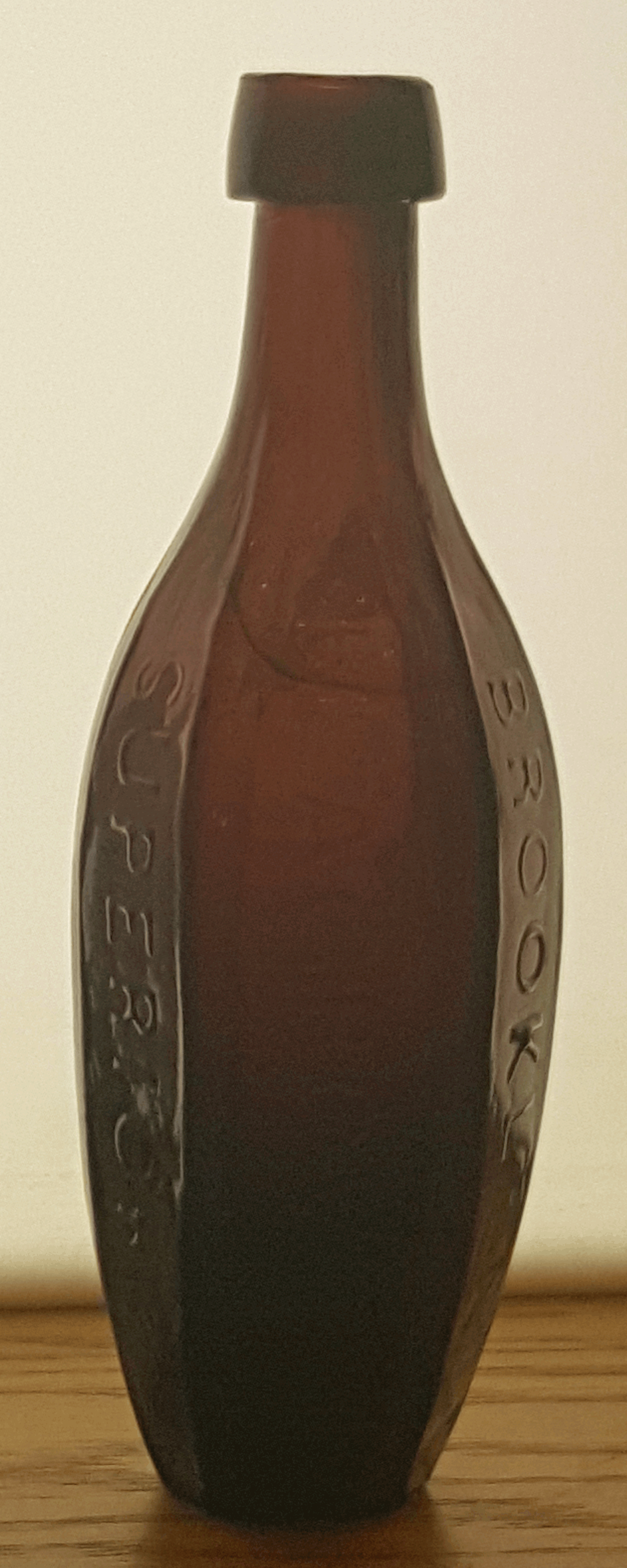
- This bottle is very old and dates prior to 1850 and
as such has the desirable pontil
- This bottle is rare. There is one confirmed
example and a second bottle reported. This bottle
has not sold publicly in over 30 years, but one of the
private sales was said to have been multiples of
$10,000, the highest price paid for a soda bottle, just
not on the record.
- This bottle has an unusual appearance that is unique
in several ways. Although it does not have a
picture, it is tenpin shaped and six sided. There
are only four six sided ten pin bottles known and they
are all likely made from the some modified mold at later
dates. Tenpins are rare and six sided tenpins are
super unusual.
- Color is king and this bottle is a rich puce color.
Although there are other puce sided bottles, this is the
only tenpin bottle in puce.
So what do we know about Blagrove and his bottle.
The first question is what Blagrove? There were two
contemporary Blagroves in Brooklyn when this bottle was
produced. On was Charles J. Blagrove who was a
druggist at 105 Fulton on the corner of Main and the second
was William P. Blagrove who was a druggist for many years in
the Squire building on 115 Atlantic on the corner of Willow.
Charles J. Blagrove was born about 1817 in the District
of Columbia and purchased a drug store from Dr. Charles Ball
just prior to 1838 in Brooklyn. In an odd twist of
fate, some of the old stock of magnesia that he sold
contained arsenic and killed a Mrs. Randolph soon after he
started his operation. A few years later in 1843, his
drugstore burned to the ground. Although he had a
rough start as a young business man, he succeeded and served
the community as a druggist in Brooklyn and thru at least
1870.
William P. Blagrove was born on May 18, 1807 in Boston,
Massachusetts. He succeeded his father as a patent agent in
New York City in 1829 and by 1831 was a druggist in
Brooklyn. With a move to a location, William P. joined
with Robert A. Powers in the partnership of Blagrove &
Powers in the spring of 1834. This firm advertised
soda water for sale as was the custom of many leading
druggists during this period. This partnership was
dissolved in January of 1839 and Blagrove continued the
druggist business on his own. He was in business thru
at least 1852 and died on March 23, 1853.
I 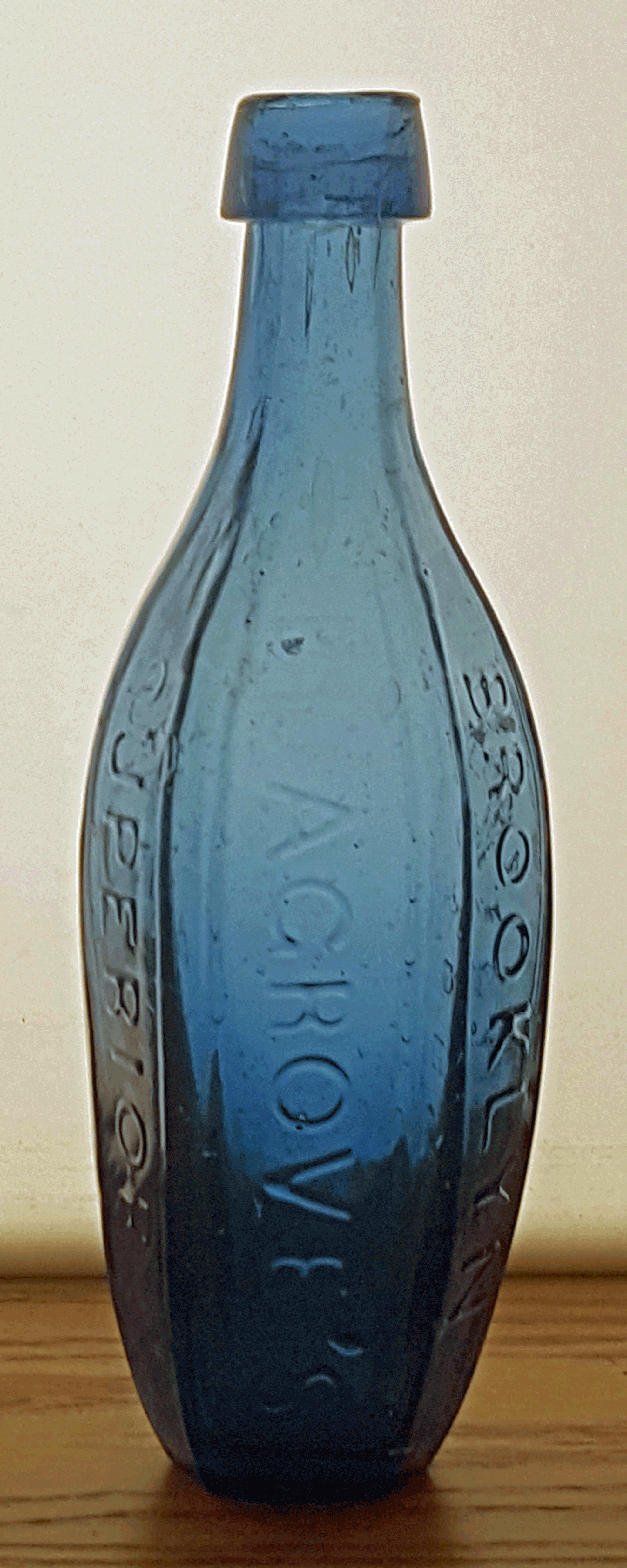 suspect that the two Blagroves were brothers.
They were several times listed together in News Paper ads.
Their father, being in the patent agency business, would
have lived or spent a fair amount of time in Washington, D.
C. The question is what brother used the top American
soda water bottle? The answer is in this notice that
appeared in the Brooklyn Daily Eagle on September 24, 1847: suspect that the two Blagroves were brothers.
They were several times listed together in News Paper ads.
Their father, being in the patent agency business, would
have lived or spent a fair amount of time in Washington, D.
C. The question is what brother used the top American
soda water bottle? The answer is in this notice that
appeared in the Brooklyn Daily Eagle on September 24, 1847:
A PLEASANT BEVERAGE.-All the
world of Brooklyn and vicinity are acquainted with the
merits of Blagrove's delicious soda water. He
makes it pleasant and healthful to a degree which we do
not know to have to have been attained by any other
manufacturer. Indeed by the high estimation in
which it has for years been held, he has commenced
bottling of the same kind as he has heretofore sold from
the fountain. It is highly charged with gas and
requires a bottle of particular shape and great strength
to contain it. His place is in Atlantic street
near the tunnel.
Since
William P. Blagrove was located on Atlantic Avenue, we know know this is his bottle. The "peculiar shape"
mentioned in the article seals the deal that this is the
bottle and it dates to 1847. Since no other reference
can be found to Blagrove's bottling operation, this must
have been a short lived operation explaining the rarity of
this bottle. And just for the record this bottle also
comes in blue making a fine set of bookends.
Bottle images courtesy of Eric Schmetterling.
|
|

